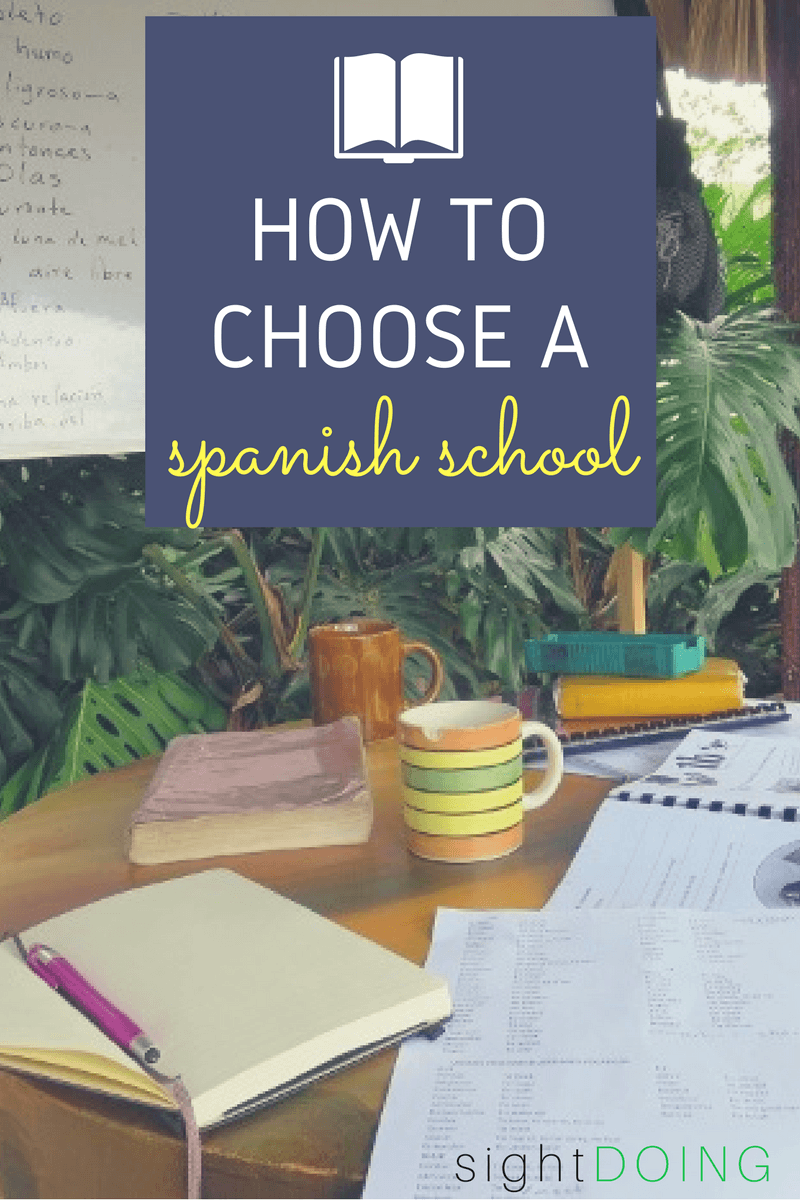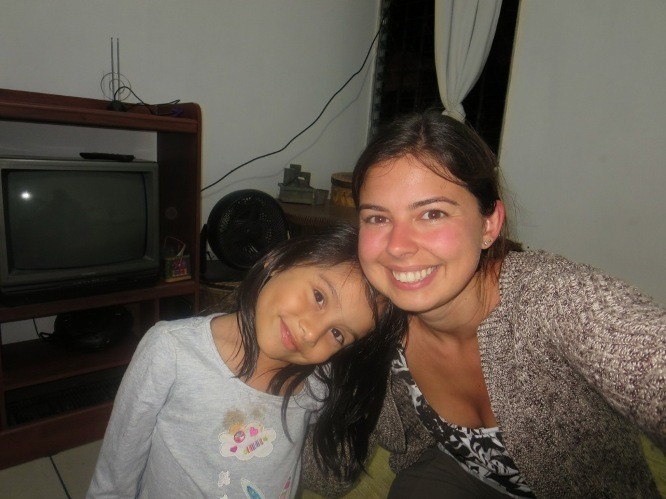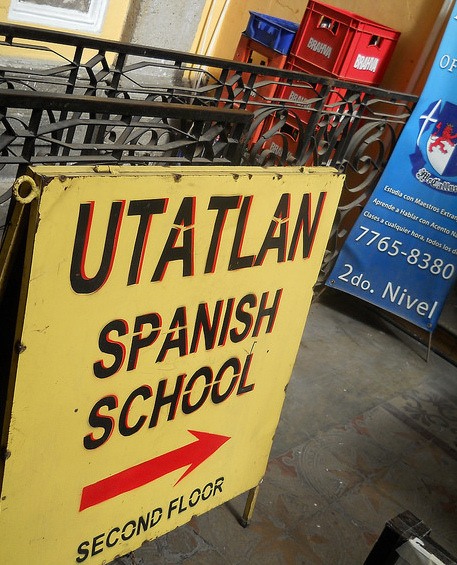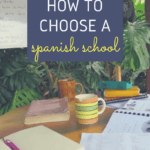This post may contain affiliate links. As an Amazon Associate I earn from qualifying purchases.
* * *
With hundreds of schools to choose from, I was overwhelmed with how to choose a Spanish school. I knew I wanted an immersion program, forcing me to practice round-the-clock so I was guaranteed to improve my skills. Beyond that, it was hard to narrow things down.
After trying six different Spanish schools in Guatemala (and 1 in Mexico), I can finally say that there is definitely a strategy on how to choose a Spanish school that works for you.

Choose the Right Accent
If you’re new to Spanish, you may not realize how many variations there are in dialect, accent, and slang between different regions. Mexican Spanish differs from Puerto Rican Spanish in many ways and Castllian Spanish (from Spain) is a whole different animal.
If you want to learn how to speak Spanish for a specific need, such as working with people in your community, try to study in the country they’re from. You’ll learn the phrasing they use, get accustomed to their accent, and get a better understanding of their culture for context.
For a generic approach, choose a Spanish school in Guatemala or Colombia for clear accents and slightly slower speech (which makes it easier to learn).
Find a Location That Fits Your Travel Style
Most Spanish schools require you to spend a minimum of one week in a single city, so you might as well find a location that fits your needs. That means different things to different people, so think hard about what you’re looking for.
- Do you want a city that has lots of tourist attractions to explore during your spare time?
- Do you want somewhere without distractions to keep you focused on your skills?
- Do you want to volunteer for half days?
- Do you need somewhere with excellent wi-fi to work remotely?
Mythbusting on How to Choose a Spanish School!
Before my studies, I was warned that Spanish immersion programs in touristy destinations aren’t the best option because it’s too easy to fall back to English when you’re struggling.
I found this to be untrue, but it comes down to your personal discipline. In my experience, locals (even in tourist cities) love it when you practice your language skills and showed their appreciation with patience and encouragement.
In addition, since many locals were studying English in order to get jobs in tourism/hospitality, they were more than happy to try an “intercambio“, where I helped them with English in exchange for Spanish practice.
Think About Your Goals
My goal was conversational Spanish, with a focus on speaking and listening. Being able to read and write were secondary skills that I figured would improve a little no matter what, but weren’t my priority.
Most schools can coordinate to your preferences as long as you’re upfront about your intentions in advance.
How to Choose a Spanish School: Private Tutors or Group Learning?
I have zero patience to waste time on lessons that I’ve already mastered or that are irrelevant to me, so I knew it would be worth the splurge to have one-on-one classes with a private teacher. For other people, they know that having other students would help motivate them.
Not all Spanish schools offer both options, so make sure you’re factoring this into your decision.
Look at the Extra Services a School May Provide
I saved a lot of money by choosing programs that were 3-4 hours of formal instruction daily instead of a full day of classes. Many schools supplement with free optional field trips, discussion groups, and social activities where you can practice outside of class itself.
Many schools, particularly in Latin America, also offer homestay placements for a more immersive experience without having to seek a family out on your own.

You may also find value in schools that are willing to arrange transportation or tours for you, although in many spots it can be advantageous to do that independently.
Consider Your Budget
There’s a wide range in costs for attending Spanish school dictated by location, facilities, class size, extra services, and office administration. Quality of instruction, in my experience, is strangely not always correlated to cost of school!
I chose Guatemala as my primary base because lessons are extraordinarily cheap while still being a relatively comfortable place to “live”.

That said, I paid about double the rate for a week in Mexico and still found it to be great value for my goals in that particular week.
More Tips for Learning How to Speak Spanish
Don’t commit to more than your first week: Unless you’re visiting over a holiday, Spanish schools rarely sell out in advance. By all means, get a reservation for your first week of studies, but don’t plan too much after that. By midweek, you’ll know if their teaching style, homestay, and even the city you’re in is good enough to stick around (or if you need to shop for something different.)
Does it sound scary to not plan all your school/travel in advance? It did for me! But if you go to class on Monday & Tuesday, you’ll still have from Wednesday-Sunday to search for something different if needed. In Latin America, that’s PLENTY of notice.
Don’t burn out: If you plan on studying for an extended time, switch things up every two or three weeks so your brain doesn’t fry. A change of scenery or a change of schools (for a different teaching style) freshens things up. Better yet, take a week to travel and practice independently before resuming classes.
>>>>> Read more: My Complete Guide to Guatemala to Plan Your Trip
Opt for the homestay: Living with a local family means you have lots of chances to practice with your housemates throughout the day. As a bonus, their homes are usually in local neighborhoods (rather than the tourist center), so you’ll be bumping into neighbors and running errands at the corner store instead of an English-speaking souvenir shop.
Go all-in: You will make mistakes and embarrass yourself at some point during your studies. The quicker you come to terms with that and laugh off your mistakes, the bolder you’ll get with your practice, which will help you learn faster!
>>>>> Read more: Why I Wish I Learned to Dance Before Attending Spanish School
Don’t be Afraid to Be Specific: If you have a recommendation for a specific teacher, specific host family, or specific goal or learning style — ASK for what you want! And if something doesn’t work out for you, ask the school if you can switch teachers or schedules until you are set up for success.
Study Spanish in Guatemala
I attended two Spanish schools in Antigua: Spanish School Sevilla (sadly, it appears they closed permanently during Covid) and Ixchel Spanish School. My instructors at both were great, though I found Sevilla to be a little more flexible in customizing my coursework. Both schools were good but as an intermediate-advanced student, I found Sevilla worked better for me. New students, or anyone who wants a well-rounded education rather than a more specialized one, may find Ixchel equally attractive.
I tried one Spanish school in Xela before deciding it was WAY too formal and structured for my learning style, so I switched to Utatlan and couldn’t be happier. My 4-hour classes usually included ~45 minutes of “fun” activities, like Spanish Scrabble or conversation groups to keep me excited about learning. Plus their extracurricular activities were a great mix of local sights and short side-trips.

The first place I went to study Spanish in Guatemala was at San Pedro Spanish School, on the shores of Lake Atitlan. It’s an excellent school, but I didn’t like Lake Atitlan so I left after my Friday morning class (even though my homestay ran through Sunday). Thankfully it was cheap enough that I could afford to do so!
For reference, I also spent a week living and studying with a private tutor (not affiliated with a school) and had mixed feelings on that experience. It was an intense Spanish immersion program in Guatemala City. When you live with your instructor, you have no opportunity for a mental rest. That’s efficient but challenging.
As you can see, there’s a huge variety in experiences and learning styles. Finding what works for you is worth the effort.
The Bottom Line on How to Choose a Spanish School
No matter which school you choose, picking a Spanish immersion program is the best way to hone in on your language skills and it’s easy to switch to a different school after a week if you decide you want something different.
I’m so glad I had the opportunity to study Spanish in Guatemala and recommend it to anyone with the time and interest!
* * *
For the rest of your trip, check out my Guatemala travel guide.


I had no idea that this was even an option. I’d love to travel to a Spanish speaking country for a while and take a week or more of Spanish school! I love Spanish and since I’m in Canada where it’s NOT the second language I don’t get much access to it.
@Kathleen, I’m a little jealous of Canadians and the access to French, so I guess we’re even!
Immersion! What an excellent idea! I know when I had non-english speaking kindergarteners and they were totally immersed in English, they were fluent within a few months. I’d love to participate in an immersion program. I have always wanted to learn Spanish.
@Cathi, Kids pick up languages quickly for sure!
It’s the best way to learn a language. I was fluent in French and conversant in Spanish at one time but I’ve lost most of it which is sad.
@Patty, Unfortunately I can feel a lot of knowledge slipping away also but I think it’s like riding a bike – give it a chance, and you’ll pick it right back up.
Immersion learning just makes sense to me. There are so many things to take into consideration that it can be overwhelming. Luckily you really made the process easier to figure out with this post. I think learning this way seems much more engaging and fun!
@Desiree, Yes, new hobbies and skills can be fun!
This is great information. I think it’s important to choose the best school possible so you get the best education possible.
@Jennifer, Definitely – if you’re spending the time and money, you want to make sure it’s a good fit.
I would like to join a small foodie group tour that includes Barcelona, San Sebastián, Bilbao, etc. I would like to use my Spanish skills volunteering at our local hospitals when I return. I realize the Castilian accent I will be learning in an Immersion school in that area will be very different than the Mexican and Central Americans I would be trying to help when I return to my home in Birmingham, Alabama. Can you recommend a school in that area or perhaps somewhere else in Spain, a small, quaint town where the accent is more neutral. I took Spanish for 4 years many, many years ago, but was never fluent. How long should I plan to immerse myself before traveling?
Thank you very much!…Muchas gracias!
@Linda, I haven’t studied in Spain, so I don’t have any first-hand recommendations on schools (but those are great cities for foodies!). If you’ve already got a good grasp on Spanish, I would imagine that 4-6 weeks of hard work would get you to a very strong conversational level. But of course, there’s no “magic” number on weeks to study since it does depend on how much you remember, how hard you study, and how easily you pick up languages.
I am looking for immersion programs for me and my two school aged children in Antigua. Do you have any recommendations for a school that caters to adults and kids?
Also, you mentioned that you did not like Lake Atitlan. I am curious because I was considering a school in that location too. What bothered you?
Thank you! This blog was very helpful.
@Sasha, The vast majority of schools have programs for kids, but I don’t have any personal experience on which one(s) might be best.
I would ask two questions:
1) How many other kids are enrolled that week? I think group learning or activities is a great addition for kids.
2) How are their adult programs different from children programs? That will give you an idea if they truly cater to children or if it’s just a slight modification.
I didn’t like Lake Atitlan because it was very difficult to intermingle between tourists and locals. In Antigua and Xela (the other popular places to study), it is very easy to balance and blend both worlds.
How did you find accomodation with your tutor in Guatemala City? I am looking for school there as I have friends willing to accommodate me, however, I cannot find any schools for Spanish immersion. Any suggestions?
@Emma, I asked around on online forums and then set up lessons/accommodations independently.
Hi Becky! Great post. I am planning to do a trip like this sometime in the next year. Any chance you have more information on Spanish School Sevilla? That link is no longer working and a few school pop up with a different name. I am interested to do more research on this one.
@Sam, I hope you enjoy your experience! I asked around and unfortunately it looks like Spanish School Sevilla went out of business during the pandemic and the teachers are now at other various schools. Definitely check out other schools in Antigua, though! They’re held to a very high standard and I’m sure there are other great ones that I simply didn’t get the chance to attend.